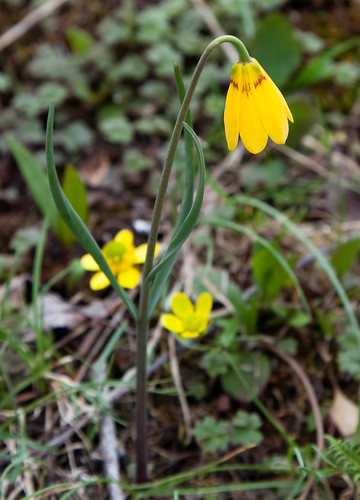Yellowbells
Fritillaria pudica
Liliaceae (Lily Family)
Okay, so this one's a softball. Look for those little yellow bells, of course! Watch where you step; they're low-growing (~3"), their faces turn down, and they're blooming now through May. The flowers can be darker near the base, with six tepals (the name for petals and sepals that are structurally the same) and a few blunt-tipped, strap-like leaves. If you dug them up (which you wouldn't, because it would destroy the whole plant and decimate our wildflower population, or course), you'd find a scaly little corm (swollen, bulb-like thing) with little corm-lets the size of rice grains attached. If you leave them be, these little bobbles (okay, they're technically called cormels) will grow into new yellowbells...and the more the merrier where these nodding cuties are concerned.
0-5000'; common throughout the northwest in short grass- and sagebrush prairie and conifer forests, with one of the widest distributions in the Fritillaria genus. Click here for MT range map

Fritillaria is from the Latin word for "dicebox", which makes sense when you look at the Snake's Head Lily, F. meleagris (right). The species pudica means "bashful"--the classic, modest "Venus pudica" pose is well-known in the art world.
Tidbits: The corms of yellowbells are edible raw (tastes like potato) or cooked (tastes like rice). Many western North American tribes picked and ate them along with Bitterroot (Lewisia rediviva), but they were never regarded as a major source of sustanance. The starchy corms also provide food for black and grizzly bears, pocket gophers and ground squirrels.
The flower is said to smell sweet as an Easter Lily, but this particular plant nerd has never gotten her nose close enough to the ground to take a sniff. Maybe this spring...
Wild gardening:
 As with many yellow flowers, Fritillaria pudica is pollinated by bees, as well as beetles and flies. It would do well in a naturalized prairie-lawn, as long as it wasn't dominated by larger plants, or would be particularly nice in a raised "miniatures" bed. Keep it in full sun to part shade, reasonably moist in spring and bone dry during its summer dormancy.
As with many yellow flowers, Fritillaria pudica is pollinated by bees, as well as beetles and flies. It would do well in a naturalized prairie-lawn, as long as it wasn't dominated by larger plants, or would be particularly nice in a raised "miniatures" bed. Keep it in full sun to part shade, reasonably moist in spring and bone dry during its summer dormancy. Yellowbells are among the first plants to bloom after the snow melts, but their flowers fade fast, the petals blushing deep red and curling backwards. Their short-lived nature only adds to their charm, as tends to happen with quick bouts of lovliness. As Ms. Dickinson pointed out,
To see the summer sky is poetry
though never in a book it lie...
True poems flee
Spotlight On... features Montana native plants that are currently on display in our natural areas. Have a plant that you'd like to see featured? Let us know!




Excellent, informative post! (By the way, I found some trilliums in bloom today at Munson Creek!)
ReplyDelete